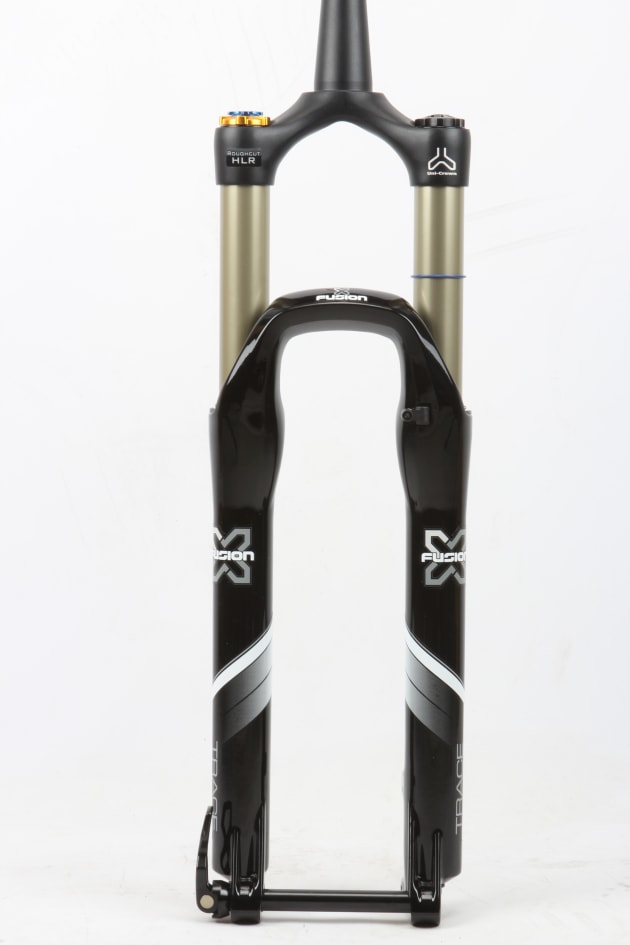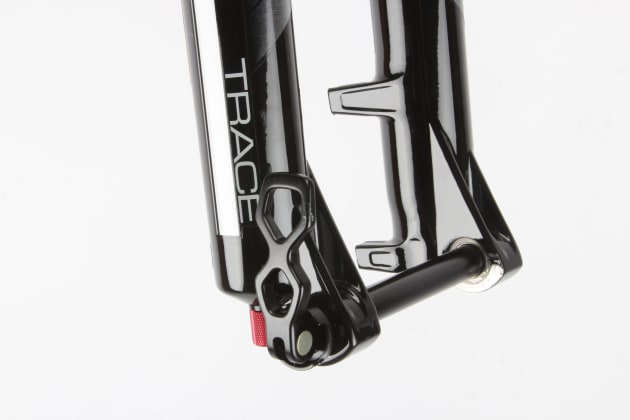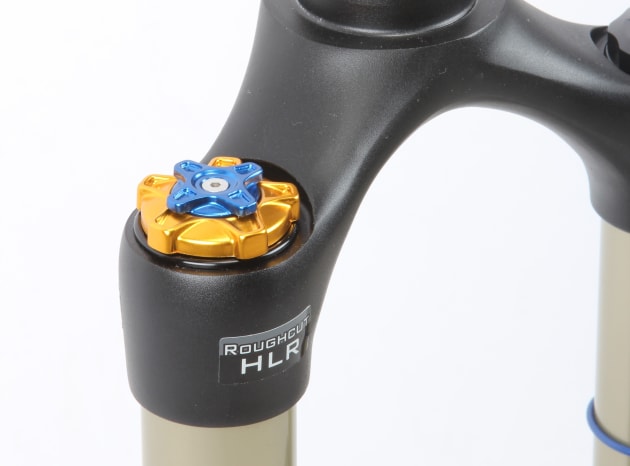X-Fusion Trace Roughcut Fork
X-Fusion has been around long enough that most riders will have heard of them, although there are still surprisingly few people in Australia who’ve actually ridden their forks. They’re pegged by most people as a mid-range brand, probably because their products usually only cost about two thirds of the equivalent item from the market leaders. Nonetheless, I’ve been seriously impressed by the X-Fusion forks I’ve ridden previously.
About a year ago X-Fusion released an all new damper for their top end forks. Dubbed Roughcut, it still featured the same high and low speed compression and rebound adjustments of the lauded HLR damper, but now in a sealed cartridge rather than the twin-tube unit it superseded.

Aside from the Roughcut damper, our test fork also featured their new one-piece crown and steerer assembly. The ‘Unicrown’ assembly is said to greatly improve stiffness and being one-piece, it’s not going to creak or come loose. The formally titled X-Fusion Trace Roughcut HLR Unicrown will set you back a coffee under $970. With an uncut steerer it weighed 1,956g including the axle (similar to a Pike and roughly 100g more than a Fox 34). The same chassis with the cheaper but still excellent RL2 damper and a two piece crown/steerer unit is a burger less than $750.
Unlike other brands, X-Fusion won’t share a fork name across different wheel sizes. This means the Trace name is reserved for 29-inch wheels. The same fork in 27.5 guise is the Sweep and the 26-inch version (gasp!) is called the Slant. Given that they share essentially the same construction and damper options, I think it’s reasonable to say that performance will be more or less identical across these models regardless of wheel size.
First up the quality and finish of the Trace is as good as anything else on the market regardless of price—the machined metal caps and adjusters are a particularly nice touch. The Trace is internally adjustable between 80, 100, 120 and 140mm of travel with a simple but reliable push-pin system; any reasonably competent home mechanic should have no problem changing it themselves should the desire arise. Our test fork was set to 140mm to fully test its all-mountain capabilities.
I’m not a fan of the X-Fusion thru-axle. The mechanism is similar to the older style Maxle quick release but doesn’t completely clear the lower fork leg when winding it in and out. As a result you need to lift the handle slightly from its engagement notch when passing the lowers, and some care must be taken to not damage the ends of said notch. Not a deal breaker by any stretch, but certainly an oversight that could be easily remedied. The only other minor niggle lies with the bolt-on U-shaped cable guide; personally I think the full wrap-around style as used on the Pike holds the brake line more securely and puts less stress on the small retaining bolt threads, but this is getting fairly picky.

The new Roughcut damper is inverted relative to the old twin-tube design, so the rebound adjuster is now on the bottom of the right leg with the twin compression adjusters on top. Apparently there are 36 clicks of rebound adjustment and 16 clicks for each of the compression dials. I say apparently because I counted about 14 on the compression dials; as with most forks, the detents don’t perfectly align with the end of adjustment range. This doesn’t really matter of course and the compression adjusters offer a nice positive click between each position. On the rebound side, the clicks are very subtle; you’ll need the ears of a bat and the fingers of a safecracker to hear or feel them in the trailhead car park. In any case, the rebound adjustment range is broad enough to cater for almost any rider weight. On the compression side, the total adjustment range seems narrower but we’ll go more into that later.
Until very recently, X-Fusion was the only fork manufacturer to offer a once-piece alloy crown and steerer unit; they’ve just been joined by Swedish über-brand Öhlins in doing so. The Unicrown is claimed to boost stiffness by almost 50%. While I’m not claiming to have put it on a test-bed, the Trace feels very solid. It’s certainly on par with other 34-35mm stanchion forks—if anything I’d say there’s a little less fore/aft deflection than its competitors, so maybe there is something to the Unicrown idea.
Tracing Lines
Threading your way through a rock garden or a series of braking ruts is entirely in your hands; the Trace will put the front wheel precisely where you tell it to. From the outset it was admirably smooth and after the first few hours, the Trace came closer to the butter-like feel of coil suspension than I thought possible for a fork at this price, or maybe regardless of price.
The Trace’s air spring doesn’t use volume spacers to change the progressiveness of the spring curve, however you can still do things the old fashioned way by adding more oil to the air chamber if you need more ramp-up. I was perfectly happy with the stock spring setup—for reference my final preferred air pressure was only a few psi higher than what I normally run my RockShox Pike.
You’ll ideally end up with around 20-25% sag when standing in the attack position; don’t set your fork pressure when you’re seated folks, unless that’s how you ride downhill! With sag set appropriately, the Trace is wonderfully supple over root balls and small rocks, rarely uses more than two thirds of its travel under normal riding, and on big hits it has just the right amount of support to prevent clanging into the bump stops when you botch a landing.
And how about that new Roughcut damper? I feel it’s a worthy successor to the old HLR model, working perfectly with the air spring to meter out just the amount of travel each impact needs without feeling either harsh or wallowy. Terrain feedback is excellent and you can detect subtle variations in trail surface intuitively through your hands. The rebound stroke can get slightly wheezy when returning from deep in the travel, but there’s no effect on performance and you’re unlikely to notice it after the first ride or two.

Both the high and low speed compression dials seem to have a comparatively narrow adjustment range. This is a good thing as the damper is already well sorted and really only needs fine tuning. The limited tuning range means there’s no chance of screwing up the performance by adding way too much or too little compression support. The fact that the damper is sealed means that even on the longest of descents the damping performance won’t start to fade—if it proves reliable (and I have no reason to suspect otherwise) it will be an absolute home run.
Tiny niggles aside, I really can’t fault the Trace Roughcut Unicrown. It delivers a magic combination of chassis stiffness, a well-sorted air spring and superbly controlled damping, and it does this at a price that no other similar-performing fork can get close to. If you want to upgrade your mid-travel fork and care more about performance and price than brands and stickers, this is the fork for you.
DIY MTB (02) 4446 4636
www.diymtb.com.au






